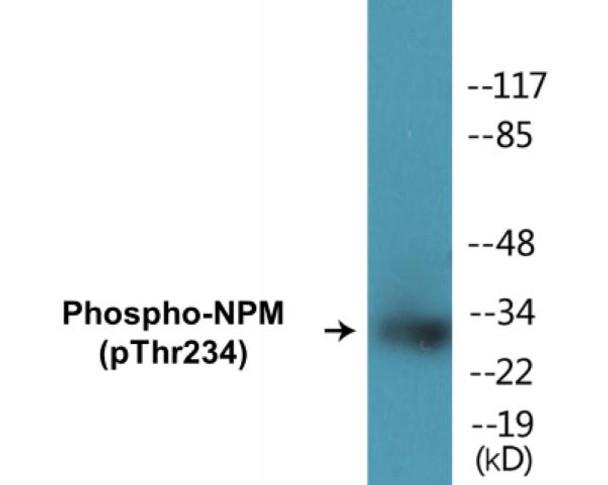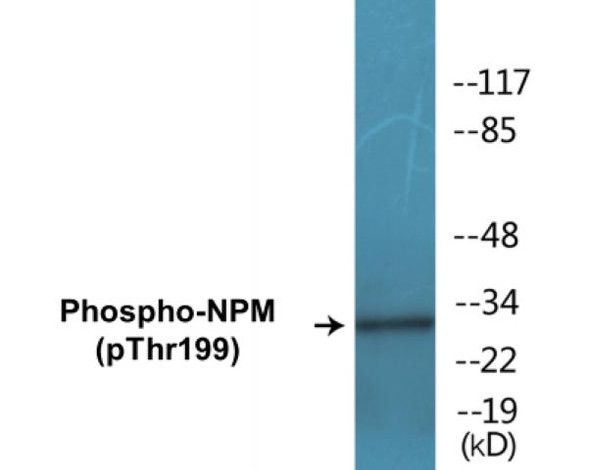Description
NPM (Phospho-Thr234)Colorimetric Cell-Based ELISA Kit
The NPM (Phospho-Thr234) Colorimetric Cell-based ELISA Kit is a cutting-edge tool for detecting and quantifying the levels of phosphorylated NPM (Nucleophosmin) at threonine 234 in cell lysates. This kit offers high sensitivity and specificity, ensuring accurate and reproducible results for your research needs.NPM is a multifunctional protein involved in various cellular processes, including ribosome biogenesis, DNA repair, and regulation of cell cycle progression. Phosphorylation of NPM at threonine 234 has been linked to cancer development and progression, making it a valuable biomarker for studying oncogenesis and potential therapeutic interventions.
With the NPM (Phospho-Thr234) Colorimetric Cell-based ELISA Kit, researchers can delve deep into the intricate mechanisms of cell signaling pathways and gain valuable insights into the role of phosphorylated NPM in disease pathology. Order your kit today and unlock the potential of your research.
| Product Name: | NPM (Phospho-Thr234) Colorimetric Cell-Based ELISA |
| Product Code: | CBCAB01473 |
| ELISA Type: | Cell-Based |
| Target: | NPM (Phospho-Thr234) |
| Reactivity: | Human, Mouse, Rat |
| Dynamic Range: | > 5000 Cells |
| Detection Method: | Colorimetric 450 nm |
| Format: | 2 x 96-Well Microplates |
The NPM (Phospho-Thr234) Colorimetric Cell-Based ELISA Kit is a convenient, lysate-free, high throughput and sensitive assay kit that can detect NPM protein phosphorylation and expression profile in cells. The kit can be used for measuring the relative amounts of phosphorylated NPM in cultured cells as well as screening for the effects that various treatments, inhibitors (ie. siRNA or chemicals), or activators have on NPM phosphorylation.
Qualitative determination of NPM (Phospho-Thr234) concentration is achieved by an indirect ELISA format. In essence, NPM (Phospho-Thr234) is captured by NPM (Phospho-Thr234)-specific primary (1ø) antibodies while the HRP-conjugated secondary (2ø) antibodies bind the Fc region of the 1ø antibody. Through this binding, the HRP enzyme conjugated to the 2ø antibody can catalyze a colorimetric reaction upon substrate addition. Due to the qualitative nature of the Cell-Based ELISA, multiple normalization methods are needed:
| 1. | A monoclonal antibody specific for human GAPDH is included to serve as an internal positive control in normalizing the target absorbance values. |
| 2. | Following the colorimetric measurement of HRP activity via substrate addition, the Crystal Violet whole-cell staining method may be used to determine cell density. After staining, the results can be analysed by normalizing the absorbance values to cell amounts, by which the plating difference can be adjusted. |
| Database Information: | Gene ID: 4869, UniProt ID: P06748, OMIM: 164040, Unigene: Hs.557550/Hs.654469/Hs.654583 |
| Gene Symbol: | NPM1 |
| Sub Type: | Phospho |
| UniProt Protein Function: | NPM1: a nucleolar protein associated with nucleolar ribonucleoprotein structures and that binds single-stranded nucleic acids. Is a major component of template activating factor (TAF)-III. It plays a role in controlling centrosome duplication, and may function in the assembly and/or transport of the ribosome. Two alternatively spliced isoforms have been described. |
| UniProt Protein Details: | Protein type:Translation; RNA-binding; Nucleolus; Oncoprotein Chromosomal Location of Human Ortholog: 5q35.1 Cellular Component: centrosome; cytoplasm; cytosol; focal adhesion; membrane; nucleolus; nucleoplasm; nucleus; ribonucleoprotein complex; spindle pole centrosome Molecular Function:histone binding; NF-kappaB binding; protein binding; protein heterodimerization activity; protein homodimerization activity; protein kinase binding; protein kinase inhibitor activity; ribosomal large subunit binding; ribosomal small subunit binding; RNA binding; Tat protein binding; transcription coactivator activity; unfolded protein binding Biological Process: activation of NF-kappaB transcription factor; cell aging; centrosome cycle; DNA repair; DNA replication-independent nucleosome assembly at centromere; intracellular protein transport; negative regulation of apoptosis; negative regulation of cell proliferation; nucleocytoplasmic transport; nucleosome assembly; positive regulation of cell proliferation; positive regulation of transcription, DNA-dependent; positive regulation of translation; protein localization; protein oligomerization; regulation of centriole replication; regulation of endodeoxyribonuclease activity; response to stress; ribosome assembly; signal transduction; viral reproduction |
| NCBI Summary: | This gene encodes a phosphoprotein which moves between the nucleus and the cytoplasm. The gene product is thought to be involved in several processes including regulation of the ARF/p53 pathway. A number of genes are fusion partners have been characterized, in particular the anaplastic lymphoma kinase gene on chromosome 2. Mutations in this gene are associated with acute myeloid leukemia. More than a dozen pseudogenes of this gene have been identified. Alternative splicing results in multiple transcript variants.[provided by RefSeq, Nov 2009] |
| UniProt Code: | P06748 |
| NCBI GenInfo Identifier: | 114762 |
| NCBI Gene ID: | 4869 |
| NCBI Accession: | P06748.2 |
| UniProt Secondary Accession: | P06748,P08693, Q12826, Q13440, Q13441, Q14115, Q5EU94 Q5EU95, Q5EU96, A8K3N7, B5BU00, D3DQL6, |
| UniProt Related Accession: | P06748 |
| Molecular Weight: | 28,400 Da |
| NCBI Full Name: | Nucleophosmin |
| NCBI Synonym Full Names: | nucleophosmin (nucleolar phosphoprotein B23, numatrin) |
| NCBI Official Symbol: | NPM1 |
| NCBI Official Synonym Symbols: | B23; NPM |
| NCBI Protein Information: | nucleophosmin |
| UniProt Protein Name: | Nucleophosmin |
| UniProt Synonym Protein Names: | Nucleolar phosphoprotein B23; Nucleolar protein NO38; Numatrin |
| Protein Family: | Nucleophosmin |
| UniProt Gene Name: | NPM1 |
| UniProt Entry Name: | NPM_HUMAN |
| Component | Quantity |
| 96-Well Cell Culture Clear-Bottom Microplate | 2 plates |
| 10X TBS | 24 mL |
| Quenching Buffer | 24 mL |
| Blocking Buffer | 50 mL |
| 15X Wash Buffer | 50 mL |
| Primary Antibody Diluent | 12 mL |
| 100x Anti-Phospho Target Antibody | 60 µL |
| 100x Anti-Target Antibody | 60 µL |
| Anti-GAPDH Antibody | 60 µL |
| HRP-Conjugated Anti-Rabbit IgG Antibody | 12 mL |
| HRP-Conjugated Anti-Mouse IgG Antibody | 12 mL |
| SDS Solution | 12 mL |
| Stop Solution | 24 mL |
| Ready-to-Use Substrate | 12 mL |
| Crystal Violet Solution | 12 mL |
| Adhesive Plate Seals | 2 seals |
The following materials and/or equipment are NOT provided in this kit but are necessary to successfully conduct the experiment:
- Microplate reader able to measure absorbance at 450 nm and/or 595 nm for Crystal Violet Cell Staining (Optional)
- Micropipettes with capability of measuring volumes ranging from 1 µL to 1 ml
- 37% formaldehyde (Sigma Cat# F-8775) or formaldehyde from other sources
- Squirt bottle, manifold dispenser, multichannel pipette reservoir or automated microplate washer
- Graph paper or computer software capable of generating or displaying logarithmic functions
- Absorbent papers or vacuum aspirator
- Test tubes or microfuge tubes capable of storing ≥1 ml
- Poly-L-Lysine (Sigma Cat# P4832 for suspension cells)
- Orbital shaker (optional)
- Deionized or sterile water
*Note: Protocols are specific to each batch/lot. For the correct instructions please follow the protocol included in your kit.
| Step | Procedure |
| 1. | Seed 200 µL of 20,000 adherent cells in culture medium in each well of a 96-well plate. The plates included in the kit are sterile and treated for cell culture. For suspension cells and loosely attached cells, coat the plates with 100 µL of 10 µg/ml Poly-L-Lysine (not included) to each well of a 96-well plate for 30 minutes at 37 °C prior to adding cells. |
| 2. | Incubate the cells for overnight at 37 °C, 5% CO2. |
| 3. | Treat the cells as desired. |
| 4. | Remove the cell culture medium and rinse with 200 µL of 1x TBS, twice. |
| 5. | Fix the cells by incubating with 100 µL of Fixing Solution for 20 minutes at room temperature. The 4% formaldehyde is used for adherent cells and 8% formaldehyde is used for suspension cells and loosely attached cells. |
| 6. | Remove the Fixing Solution and wash the plate 3 times with 200 µL 1x Wash Buffer for five minutes each time with gentle shaking on the orbital shaker. The plate can be stored at 4 °C for a week. |
| 7. | Add 100 µL of Quenching Buffer and incubate for 20 minutes at room temperature. |
| 8. | Wash the plate 3 times with 1x Wash Buffer for 5 minutes each time. |
| 9. | Add 200 µL of Blocking Buffer and incubate for 1 hour at room temperature. |
| 10. | Wash 3 times with 200 µL of 1x Wash Buffer for 5 minutes each time. |
| 11. | Add 50 µL of 1x primary antibodies Anti-NPM (Phospho-Thr234) Antibody, Anti-NPM Antibody and/or Anti-GAPDH Antibody) to the corresponding wells, cover with Parafilm and incubate for 16 hours (overnight) at 4 °C. If the target expression is known to be high, incubate for 2 hours at room temperature. |
| 12. | Wash 3 times with 200 µL of 1x Wash Buffer for 5 minutes each time. |
| 13. | Add 50 µL of 1x secondary antibodies (HRP-Conjugated AntiRabbit IgG Antibody or HRP-Conjugated Anti-Mouse IgG Antibody) to corresponding wells and incubate for 1.5 hours at room temperature. |
| 14. | Wash 3 times with 200 µL of 1x Wash Buffer for 5 minutes each time. |
| 15. | Add 50 µL of Ready-to-Use Substrate to each well and incubate for 30 minutes at room temperature in the dark. |
| 16. | Add 50 µL of Stop Solution to each well and read OD at 450 nm immediately using the microplate reader. |
(Additional Crystal Violet staining may be performed if desired – details of this may be found in the kit technical manual.)






